How to Lose Weight Fast on the Bacon Diet
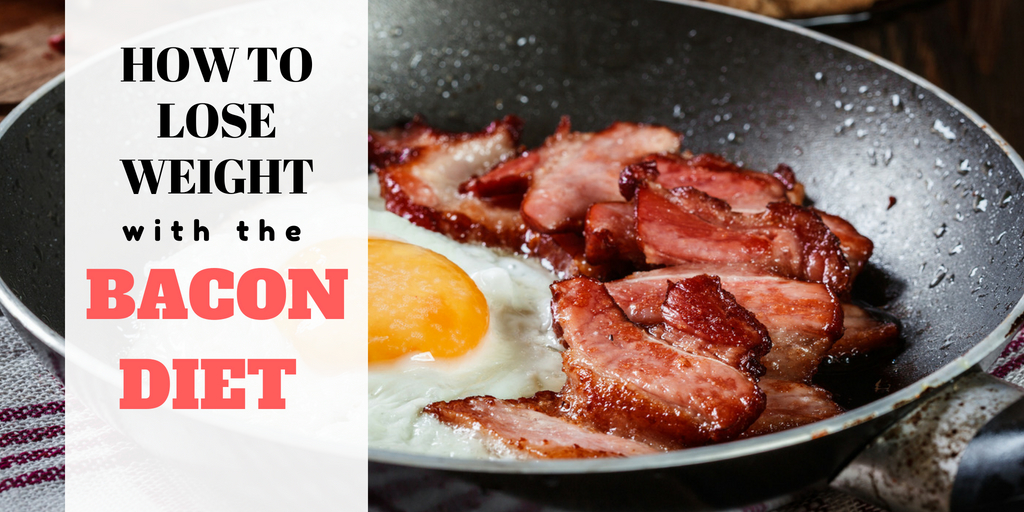
[box type="info" align="" class="" width=""]
Note to you the reader:
I realize there's a ton of misinformation on the Internet today and if you look hard enough you can find something backing up either the pro or the con of any argument or belief. That being said, when it comes to nutrition in general, the misinformation is based on biases and misrepresented case studies, medical findings, and inaccuracies across the board.
When reading through this article, please note that at the end of the day, I'm a believer in the creation of happy, healthy relationships with the food that nourishes us for the lifestyles we most want for ourselves, friends and families.
Too much of anything can be negative and lead to deterrence from our path. Do yourself a favor and continue your own self-education by watching documentaries such as " In Defense of Food " and "The Magic Pill", check out great websites like ChrisKresser.com - see article entitled, " The Nitrate and Nitrite Myth: Another Reason Not to Fear Bacon " along with some other informative articles like, "The Truth about Meat, according to Scientists".
[/box]
As a fitness professional, I remember how overwhelming it was starting down my path to self-educating on what it means to be healthy. At 15, I didn’t have a lot of options – wait for it! I’m about to date myself – I went to my local library and researched nutrition and how to lose weight.
My kids laughed pretty hard when I had to pull up a picture of a microfiche to show them this is how I had to find old articles and newspaper clippings. Back then, almost 26 years ago, all I could find was about two dozen books on the subject.
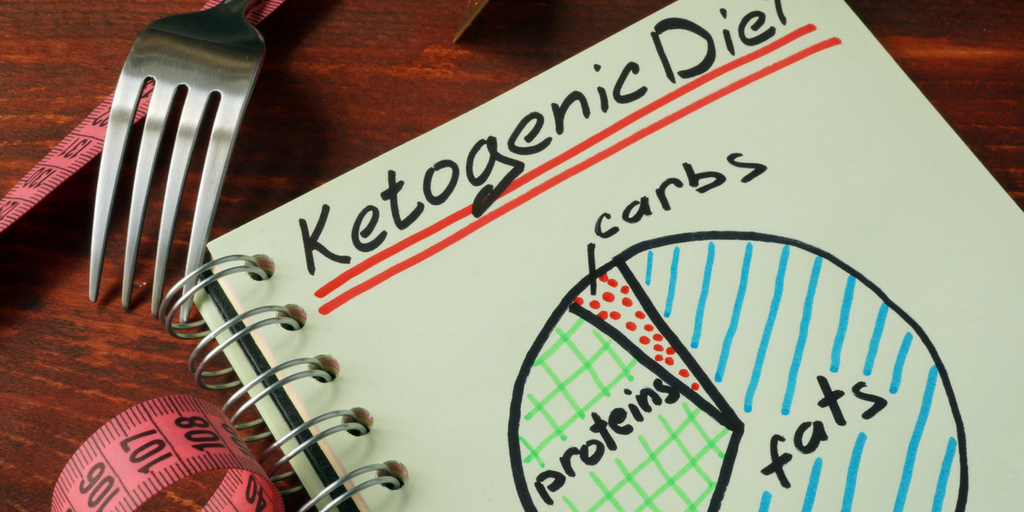
The ‘Bacon Diet’ Lifestyle…huh?
Today, typing in a similar search term into Google is like drinking from an information firehose – open wide!
We’re drowning in information and what’s more than that we’re having a heck of a time deciphering what’s a fact, fiction, fad, or truth – and most importantly, what’s actually sustainable for everyday life? After all, isn’t that what the word ‘diet’ really means – a way in which one nourishes themselves? The ‘Subway Diet’, ‘ Paleo Diet ’, ‘ Zone Diet ’, ‘ Atkins Diet ’, ‘South Beach Diet’, ‘Dr. Bernstein Diet’, ‘Mediterranean Diet’… and most recently, the one that caught my eye, ‘ The Bacon Diet ’!
https://www.youtube.com/watch?v=6AQiOU9YWcY
If you are like me, the word BACON, got your attention. Every time I see or hear the word, I start to salivate uncontrollably like one of Pavlov’s dogs. A ‘Bacon Diet’ sounds too good to be true, doesn’t it? For much of my adult life, I believed that eating too much of this mouth-watering, succulent, satiating all-day-every-day kind of meat was bad for me? Too much fat, too much salt, too much, too much, too much… but here’s a diet, not really called ‘the Bacon Diet’ by the way, but the Ketogenic Diet, which supports the idea of eating high fat, moderate protein, and low carbohydrates.
And so you know bacon along with a number of other uber yummy meats gets the green light in keto-land. So what did I have to lose? I had to dive in and experience this way of fuelling myself – and boy, did I dive all-in.
The Keto Diet: What're the Facts?
Before committing to a week in the ‘keto zone’, I had to know more facts about this diet. What I found was staggering – thank you Google and PubMed! The Ketogenic Diet has been around for over a hundred years and was originally developed as a treatment for epilepsy in children. It proved to be highly effective, reducing seizures up to as much as 50% or more in some patients. For the 1920’s and 30’s, it remained popular but was phased out over time when anti-seizure medications became the primary treatment in the 40’s.
Why the Keto Diet is called the Fat Burning Diet
The easiest way to describe the Keto Diet is a diet that is high in fats, moderate in protein and minimal in carbohydrates . The lack of carbs causes a metabolic shift called ‘ketosis’, and when in this state to body switches from using glucose to ketone bodies as an energy source. Ketones are created by the liver from fat, hence some people also refer to the keto diet as the ‘fat burning diet’.
[caption id="attachment_29001" align="aligncenter" width="640"]
 Image Source: Bodybuilding.com
[/caption]
Image Source: Bodybuilding.com
[/caption]Let me nerd out for a second here.
The body has 3 storage depots to use as our fuel:
1) carbs from food
2) protein that is converted into glucose in the liver and then used as energy
3) stored body fat and ketones
In our typical North American diet, carbohydrates are the main source of fuel , and the starches and sugar are readily broken down into glucose in the bloodstream, giving our bodies its primary energy source. This is when a hormone called insulin kicks in to remove glucose from the bloodstream as too much sugar in our blood can lead to a dangerous condition called glycosylation. Insulin converts glucose into glycogen, of which some are stored inside the liver as a fuel reserve for the brain, and the rest is stored in muscles as fuel reserves for the body.
When we don’t use our stores of glycogen through daily movement, exercise and the like, it stays put in the muscles. Our bodies can only store so much glycogen, roughly 1800 calories, and when that reserve becomes full both the muscles and liver send a signal to stop insulin production and that’s when excess glucose from all our carbohydrate-rich meals starts to build up in the bloodstream – and here’s the nut – this signals to the body to release more insulin to remove this excess glucose from our blood!
Insulin levels skyrocket, and typically as this is the norm for most North Americans today, insulin resistance eventually ensues. At this point the liver says ‘hey glucose, get out of here!’ and banishes it to our body to be stored as fat. And as you can imagine, people keep eating high carbs meals, not burning off the sugar already in our body or bloodstream, insulin levels increase and so too do our body fat stores… a vicious cycle which leads to metabolic syndrome – a set of conditions caused by insulin resistance – and a major contributing factor the increasing incidences of obesity, type 2 diabetes, heart disease, fatty liver and other metabolic issues in the world today.
What is Metabolic Syndrome? (And why should we care?)
[caption id="attachment_29003" align="aligncenter" width="735"]
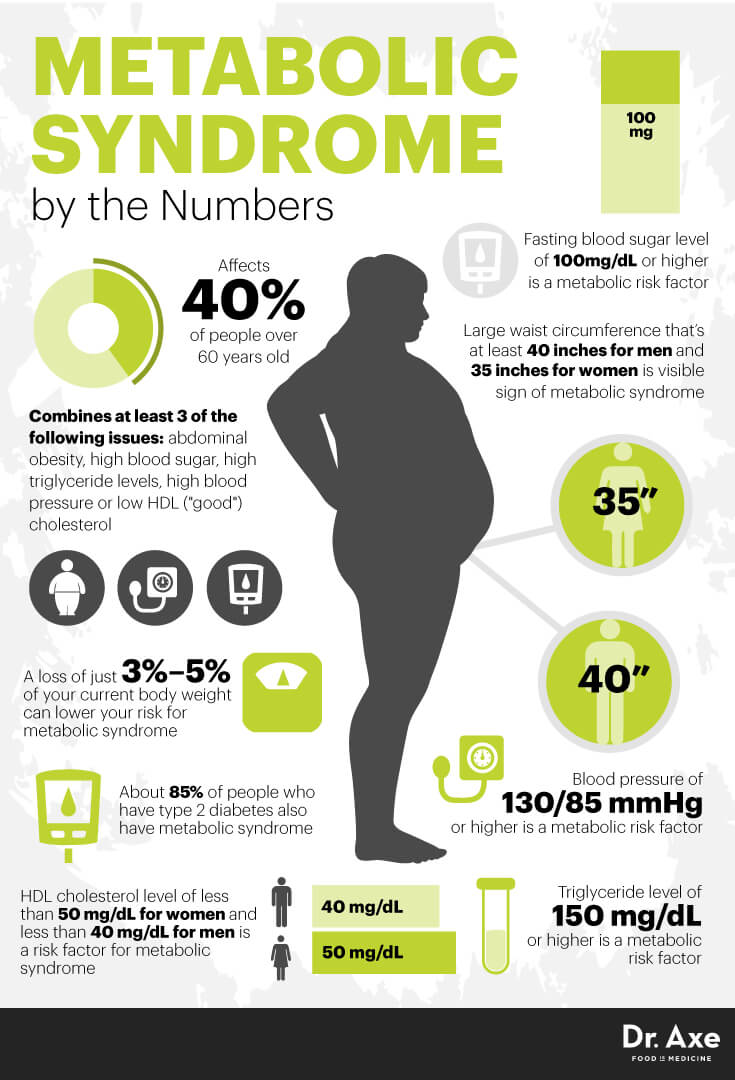 Image Source: Dr.Axe
[/caption]
Image Source: Dr.Axe
[/caption]So what does Keto have to do with this?
Everything.
Typically ketones never play a role in fueling the body or energy production, but during a Ketogenic, low-carb diet, ketones become the key player in fueling us and at the same time within our bodies, flips on a ‘fat burning’ switch. When we limit the intake of carbs, in particular when we eliminate starches and sugars, the body goes into a state of lipolysis.
Lipolysis is an extremely efficient biochemical pathway to weight loss and has a long list of scientific data backing it up as a fantastic alternative to using glucose for energy. Lipolysis starts when the body begins to burn fat stores for energy instead of the carbs obtained from our diets. By-products of this fat burning process are ketones, and so, ketosis is the secondary process of lipolysis. By lowering the intake of carbs, which the body will use for energy firstly whenever available, it’s forced to use its fat stores instead, which is otherwise known as ketosis. Ketones pack a powerful punch and next to glucose is the only other form of energy which our body can utilize.
And here's the kicker, ketosis provides adequate fuel for cells, the brain, and other organs just like glucose from carbs, BUT, unlike when the body uses glucose from carbs for energy, ketosis doesn’t store fat, AND allow the body to burn stored fat for fuel. Hello!?
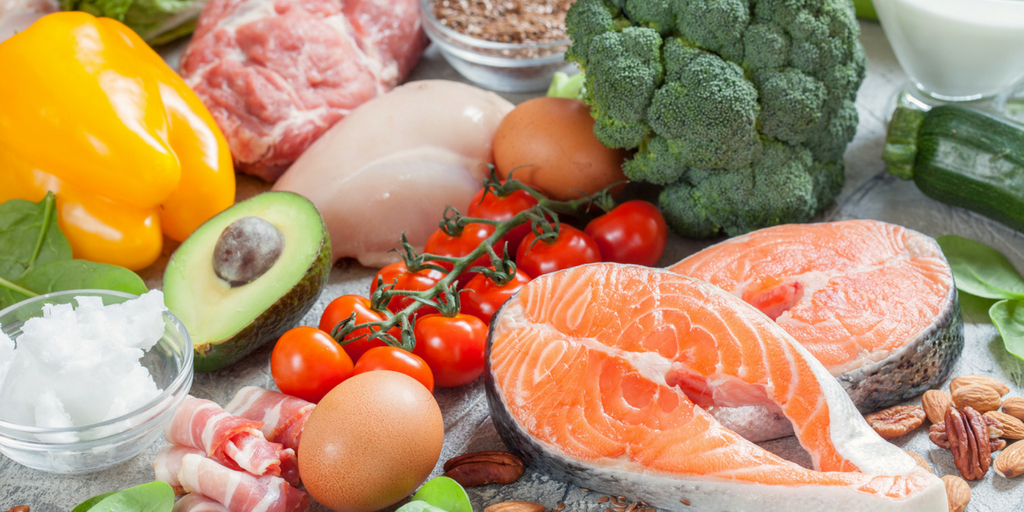
How to Get Started with the Ketogenic Diet?
There are 4 distinct plans which you’ll find as you start your own research into figuring out which is ideal for you:
1. The Standard Ketogenic Diet is 75% of your calories from fat, 20% protein and 5% carbs.
2. High-Protein Ketogenic Diet which is 60% fat, 35% protein, and 5% carbs.
3. Cyclical Ketogenic Diet which is great for bodybuilders and athletes participating in high-intensity sports or exercise. The typical breakdown is 5 days of keto followed by 2 high carb intake days.
4. Targeted Ketogenic Diet which works well for athletes, bodybuilders and the like, as it allows dietary intake of carbohydrates to increase workout schedules.
[caption id="attachment_26286" align="aligncenter" width="1100"]
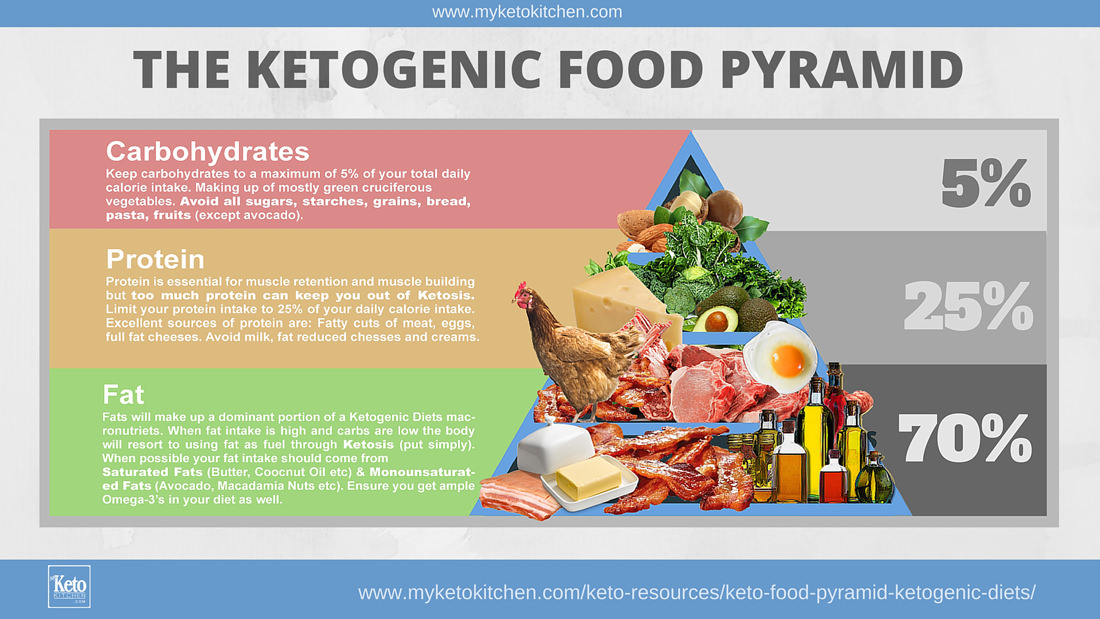 Photo Credit: MyKetoKitchen.com[/caption]
Photo Credit: MyKetoKitchen.com[/caption]3 Basic Rules to Know before You Start Dabbling with Ketosis
Here are a few basic rules to keep in mind before starting to go ‘keto’:
Keto Rule 1: Use the Net Carb Formula
Normally when people (me included!) start the keto diet, it’s recommended to aim for 50 grams of carbs per day or less, and in many cases less than 20 grams per day for the first week or two. Most of the carbs you do eat should come from non-starchy vegetables. Think green, fibrous veggies like kale, spinach, cucumber, though many other low carb vegetables are fine. Always eat a carb food with protein or a fat, for example, a piece of cheese with cucumbers or spinach with chicken. Note: fiber is not like a typical carb – it doesn’t get converted into glucose in the body. In fact, it lessens the glycemic load of carb-rich foods, which is a good thing for both energy, metabolism, and satiety. So when looking at foodstuff, use the net carb formula.
Total Carb Count – minus the Fiber Count = Equals Net Carbs
i.e. an avocado has 34 grams of carbs, and 26 grams of fiber, which would yield a total of 8 grams net carbs.
Keto Rule 2: Eat lots of Healthy Fats
EAT LOTS of healthy fats – don’t be afraid! Fat is 90% ketogenic. Remember that in ketosis fat is the main energy source for the body, they’ll not only help you feel satiated, eliminate sugar cravings and fuel your body, but they’re also essential building blocks for important hormones and bodily structures. The best fats are monounsaturated and saturated, including olive oil, avocado oil, coconut oil, grass-fed butter, ghee, red meat, BACON. Natural whole fats are always best! And of course, depending on your weight loss goals, fat intake is variable.
[caption id="attachment_15568" align="aligncenter" width="300"]
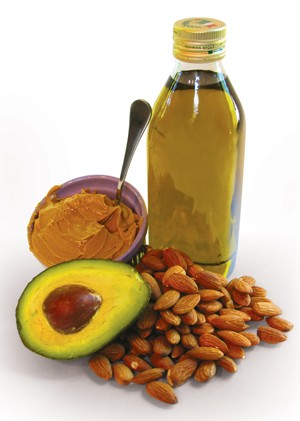 Good FATS[/caption]
Good FATS[/caption]Keto Rule 3: Get Enough Protein in your Diet
Get enough protein in your diet. Aim for 20 to 35 percent of your calories to come from protein. BUT, be warned, there’s such a thing as too much of a good thing - protein is both ketogenic and antiketogenic. Some protein will convert to glucose in the bloodstream and inhibit ketosis, so your intake should be enough to prevent muscle loss, but not so much that it will shut down ketosis. For me, I found it best to get about 25% of my daily calories from protein. A good rule of thumb, sedentary lifestylers should aim for 0.69 to 0.8 grams of protein per pound of lean body mass; for those who are mildly active, aim for 0.8 to 1.0 gram per pound of lean body mass; and those that exercise regularly with heavy resistance training, shoot for 1 to 1.2 grams per pound of lean body mass.

What I noticed by becoming 'Keto Adapted'
When I set out to do a week on the ketogenic diet, I noticed a number of things happening...
Firstly, I suffered what is called the ‘ keto flu ’, which is characterized by low energy, mental fogginess, sleeping troubles, food cravings and hunger. Yup. I had it for about 48 hours. After doing some digging I came to the conclusion that it was all my own doing for not keeping myself well hydrated and topped up with electrolytes, which only compounded the sugar withdrawal I was felt both physically and emotionally. Even though I didn’t eat much sugar, I obviously still had enough of it that my body naturally craved it.
Many of these symptoms can be alleviated by upping fat intake, drinking lots of water and increasing one’s electrolytes – I used a product called Ketoprime which is specifically designed to help one alleviate the keto flu, as well added in pink Himalayan sea salt to some of my dishes and water. The more I read on keto, I realized that there’s a large variance of how quickly people become ‘ keto-adapted ’. This is where your body fully switches into a state of ketosis, utilizing ketones for fuel. I picked up some ketone urine test strips, (cost is about $10 for a pack of 50) and started to monitor my ketone levels.
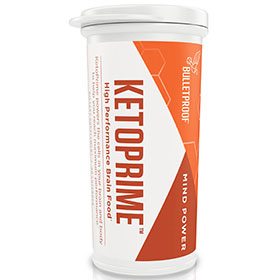
Nutritional ketosis is defined by serum ketones ranging from 0.5 to 3.0 mM – I find I’m optimal around 1.5. Elevated ketones sometimes also produce a fruity smell to your urine and your breath, this is temporary, however, and I don’t really think of it as a negative, but maybe that’s just me. Some people report constipation as a side effect, but this is easily avoided if you are paying attention to fiber intake. Avocados, flax and chia seeds and most leafy greens are high in fiber to make sure they’re your primary carb source.
I did notice that I had a loss of appetite and experienced some bouts of insomnia. It’s weird when you start shifting into ketosis and get through the flu state, the amount of energy you feel and focus your experience is awesome, but I noticed after only 4 hours sleep I’d wake up and feel fully rested and wide-awake.
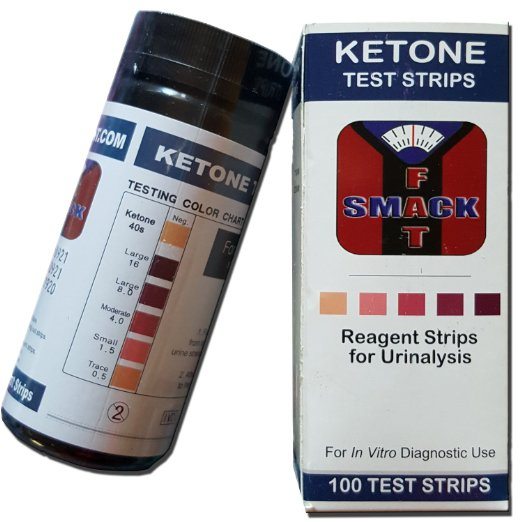
Over the past 5 years, the keto diet has seen a resurgence that is fueled by more than just personal results. Between the National Institute of Health, the American Journal of Clinical Nutrition, Duke, Stanford, and the Mayo Clinic to name just a few, which provide compelling info supporting the benefits of low carb, ketogenic-like nutrition programs.
Beyond weight loss: a review of the therapeutic uses of very-low-carbohydrate (ketogenic) diets discusses the therapeutic potential in several medical conditions, including “diabetes, polycystic ovary syndrome, acne, neurological diseases, cancer and the amelioration of respiratory and cardiovascular disease risk factors”. Other studies indicate that it can be an effective treatment for heart disease , cancer , epilepsy , Alzheimer's , Parkinson's , and even brain injury.
So, all this sounds too good to be true, and ultimately begs the question…
Is the Ketogenic Lifestyle for everyone?
You need to be the judge of that. Take your time, do your due diligence, and when you’re ready to dip your toes in the water – or better yet, fingers in the bacon grease – to see if keto is for you, I suggest starting with one simple thing… start your day with a Bulletproof Coffee. I’ve included the simple yet powerful recipe below, just give it a try for two weeks.
Drink it first thing each morning on an empty stomach, and after a couple of weeks tell me you don’t feel the difference this one small change has on your energy, metabolism and brain function. It’s how I got started 5 and a half years ago. And just think, next time you feel the urge to take a drink from the information firehose, you can say ‘no thank you, pass the bacon please’.
https://www.youtube.com/watch?v=kwIBghzhMPI
The Bulletproof Coffee Recipe of Awesomeness

Butter in my coffee? Seriously? Why would I want to do that? This was my thinking when I was first introduced to the idea of Bulletproof Coffee. But once I got past the shock, I had to find out if all the hype was true. Would this coffee really boost my energy, increase my mental clarity and help me lean out - the short answer - yes it did. It's been a huge part of elevating my lifestyle, starting with my health first...
- 12 ounces Fresh brewed coffee (Make sure to use a 'single source origin' coffee)
- 1 to 2 tbsp Brain Octane
- 1 to 2 tbsp Grass-fed Ghee (Or, use 1 grass-fed, unsalted butter)
- 2 tbsp Upgraded Collagen Protein
-
Using a French Press if you have one, brew 12 ounces of coffee using filtered water, just off the boil, with 2.5 heaping tablespoons of freshly ground single origin coffee beans. (I suggest Bulletproof Coffee Beans)
-
Add in 1 to 2 tablespoons of Brain Octane to the hot coffee (note, if your first time trying this recipe, use 1 tablespoon - it's strong and you will want to work up to the full 2 tablespoons over several days)
-
Add in 1 to 2 tablespoons of grass-fed ghee (or, unsalted, grass-fed butter)
-
Add in 2 tablespoons of Bulletproof Upgraded Collagen protein.
-
Mix it all in a blender for 30 seconds until it is frothy like a super-yummy, foamy latte.




































































































